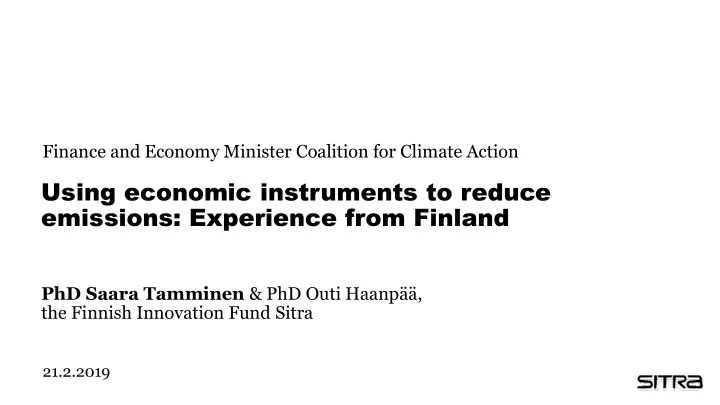

Finance and Economy Minister Coalition for Climate Action Using economic instruments to reduce emissions: Experience from Finland PhD Saara Tamminen & PhD Outi Haanpää, the Finnish Innovation Fund Sitra 21.2.2019
Economic instruments widely used in Finland… - Finland has been a forerunner in using economic instruments to reduce emissions - The first country to introduce a carbon tax in 1990 - Environmental taxes amounted to 3.1% of GDP in 2016 (EU average 2.4% of GDP) - In addition, Finland has participated in the EU Emissions Trading Scheme (EU ETS) since 2005 covering 46% of the Finnish emissions
National green economic instruments Innovation Instrument Fiscal budget (2017) Fiscal effect CO2 effect effect Tax instruments and payments ↑↑ ↓ (Ind.) ↑ (Ind.) CO2 tax (motor fuels, coal and gas) 0.6% over GDP (1340 MEUR) ↑↑ ↓ (Ind.) ↑ (Ind.) Energy content tax (motor fuels and electricity) 1.5% over GDP (3320 MEUR) ↓ /0 ↓ /0 ↑ (Ind.) Annual vehicle and new car sales tax 0.9% over GDP (2180 MEUR) ↓ /0 (Ind.) ↑ ↑ (Ind.) Waste tax and excise duty on beverage packages 12 mEUR + 16 mEUR Subsidies and other instruments 0 ↓↓ +/0 (Ind.) Blending requirement for motor fuels - ↓ ↓↓ ↑ (Ind.) Feed-in-tariff for renewable energy 0.3% of GE (170 mEUR) n.a. ↓ ↑ (Ind.) Energy Aid Programmes 0.1% of GE (60-70 mEUR) Ind. = Indicative or mixed research results, (↑) ↑ = (strong) positive effect from the tax/subsidy, 0 = no effect, (↓ ) ↓ = (strong) negative effect from the tax/subsidy, n.a. = effect not known.
Lessons learned from Finland 1 Green economic instruments can reduce emissions , raise tax revenue and boost green innovations 2 The impact of each instrument depends on the way it is posed (especially the level & target group); companies respond to price signals stronger than consumers 3 Most efficient way to introduce a CO2 tax is to target primary energy consumption 4 Emission cuts in transport sector have been more challenging than in non-road sectors, but a drop in electric cars’ price could help in the future
…But a more systematic reform is needed - Although Environmental Tax Reform (ETR) is not a new concept is Finland, many parliamentary parties and research institutes are calling for a more extensive ETR - Finnish Innovation Fund Sitra is undertaking a series of research to investigate opportunities and concrete measures to implement a wider ETR in Finland ▪ Three different policy package to demonstrate different policy priorities : 1. “Circular Economy Package” to reduce emissions and promote circular economy and efficient use of natural resources 2. “Industry package” to target emissions in the EU ETS sectors 3. “Consumer package” to tackle emissions particularly in the transport sector and consumer goods
Macroeconomic modelling to study the expected impacts - In all packages the extra revenues raises are recycled back to the economic through decreases in corporate/income taxes and/or lump sum transfers - We also estimate the impacts on GDP growth and employment to understand the dynamic impacts of the policy reform - Distributional impacts also of key interest - The “Circular Economy Package” ready with positive results on employment and economy and negative impact on emissions - For other packages research still ongoing - The packages demonstrate that there are different ways of implementing an ETR – No “one size fits all solution”
Strong coordination and cooperation needed for a successful policy reform - Sitra welcomes the report “Fiscal Policies for development and climate action” - The report clearly argues the case for an ETR while also communicating the challenges - While finance ministries hold the keys to economic instruments, all policies including an ETR need inter-ministerial coordination and strong buy-in - Use the planning and implementing processes related to the (i)NDC for inter-ministerial coordination - Use existing social safety net programmes to tackle any adverse impacts inequality or poverty - National research institutes can provide valuable data and research support
sitra.fi | seuraavaerä.fi @sitrafund
Recommend
More recommend